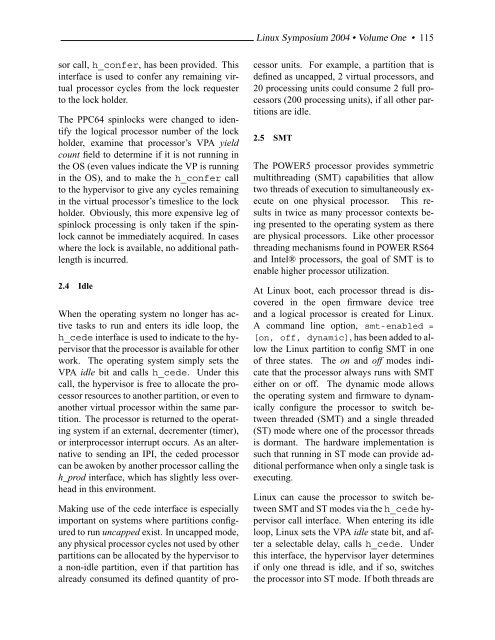You also want an ePaper? Increase the reach of your titles
YUMPU automatically turns print PDFs into web optimized ePapers that Google loves.
<strong>Linux</strong> Symposium 2004 • Volume <strong>One</strong> • 115<br />
sor call, h_confer, has been provided. This<br />
interface is used to confer any remaining virtual<br />
processor cycles from the lock requester<br />
to the lock holder.<br />
<strong>The</strong> PPC64 spinlocks were changed to identify<br />
the logical processor number of the lock<br />
holder, examine that processor’s VPA yield<br />
count field to determine if it is not running in<br />
the OS (even values indicate the VP is running<br />
in the OS), and to make the h_confer call<br />
to the hypervisor to give any cycles remaining<br />
in the virtual processor’s timeslice to the lock<br />
holder. Obviously, this more expensive leg of<br />
spinlock processing is only taken if the spinlock<br />
cannot be immediately acquired. In cases<br />
where the lock is available, no additional pathlength<br />
is incurred.<br />
2.4 Idle<br />
When the operating system no longer has active<br />
tasks to run and enters its idle loop, the<br />
h_cede interface is used to indicate to the hypervisor<br />
that the processor is available for other<br />
work. <strong>The</strong> operating system simply sets the<br />
VPA idle bit and calls h_cede. Under this<br />
call, the hypervisor is free to allocate the processor<br />
resources to another partition, or even to<br />
another virtual processor within the same partition.<br />
<strong>The</strong> processor is returned to the operating<br />
system if an external, decrementer (timer),<br />
or interprocessor interrupt occurs. As an alternative<br />
to sending an IPI, the ceded processor<br />
can be awoken by another processor calling the<br />
h_prod interface, which has slightly less overhead<br />
in this environment.<br />
Making use of the cede interface is especially<br />
important on systems where partitions configured<br />
to run uncapped exist. In uncapped mode,<br />
any physical processor cycles not used by other<br />
partitions can be allocated by the hypervisor to<br />
a non-idle partition, even if that partition has<br />
already consumed its defined quantity of processor<br />
units. For example, a partition that is<br />
defined as uncapped, 2 virtual processors, and<br />
20 processing units could consume 2 full processors<br />
(200 processing units), if all other partitions<br />
are idle.<br />
2.5 SMT<br />
<strong>The</strong> POWER5 processor provides symmetric<br />
multithreading (SMT) capabilities that allow<br />
two threads of execution to simultaneously execute<br />
on one physical processor. This results<br />
in twice as many processor contexts being<br />
presented to the operating system as there<br />
are physical processors. Like other processor<br />
threading mechanisms found in POWER RS64<br />
and Intel® processors, the goal of SMT is to<br />
enable higher processor utilization.<br />
At <strong>Linux</strong> boot, each processor thread is discovered<br />
in the open firmware device tree<br />
and a logical processor is created for <strong>Linux</strong>.<br />
A command line option, smt-enabled =<br />
[on, off, dynamic], has been added to allow<br />
the <strong>Linux</strong> partition to config SMT in one<br />
of three states. <strong>The</strong> on and off modes indicate<br />
that the processor always runs with SMT<br />
either on or off. <strong>The</strong> dynamic mode allows<br />
the operating system and firmware to dynamically<br />
configure the processor to switch between<br />
threaded (SMT) and a single threaded<br />
(ST) mode where one of the processor threads<br />
is dormant. <strong>The</strong> hardware implementation is<br />
such that running in ST mode can provide additional<br />
performance when only a single task is<br />
executing.<br />
<strong>Linux</strong> can cause the processor to switch between<br />
SMT and ST modes via the h_cede hypervisor<br />
call interface. When entering its idle<br />
loop, <strong>Linux</strong> sets the VPA idle state bit, and after<br />
a selectable delay, calls h_cede. Under<br />
this interface, the hypervisor layer determines<br />
if only one thread is idle, and if so, switches<br />
the processor into ST mode. If both threads are

















